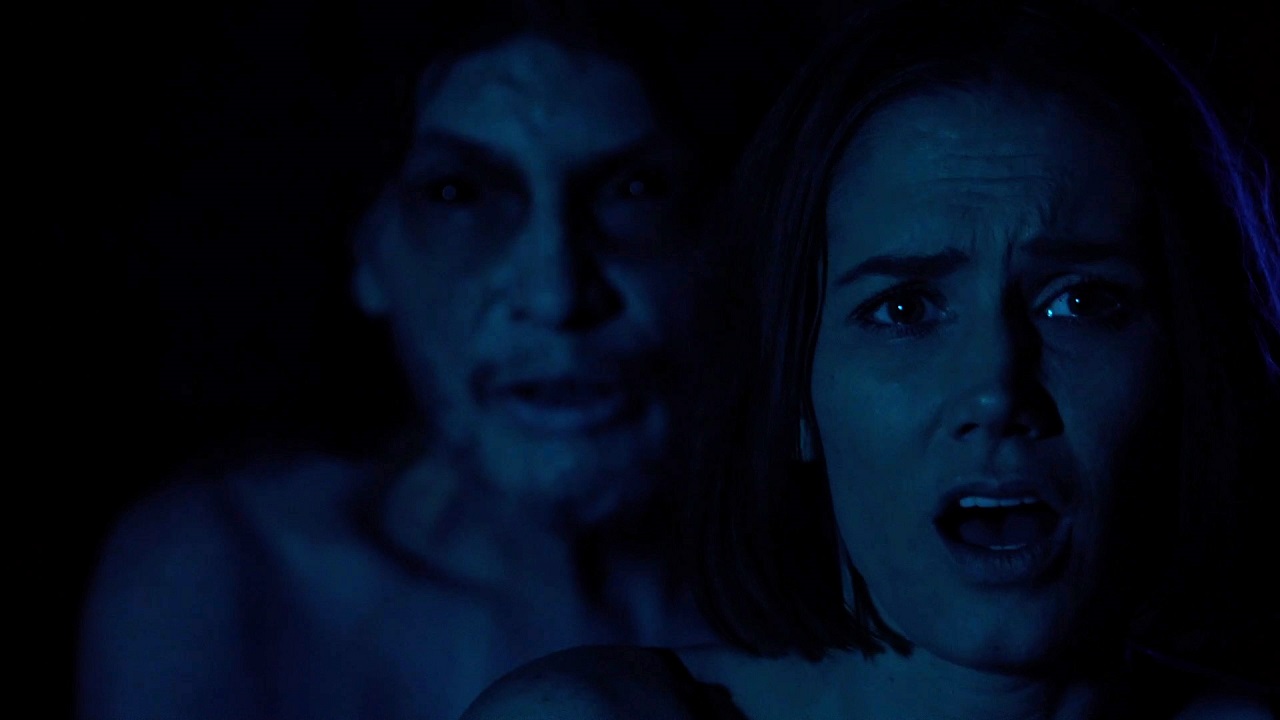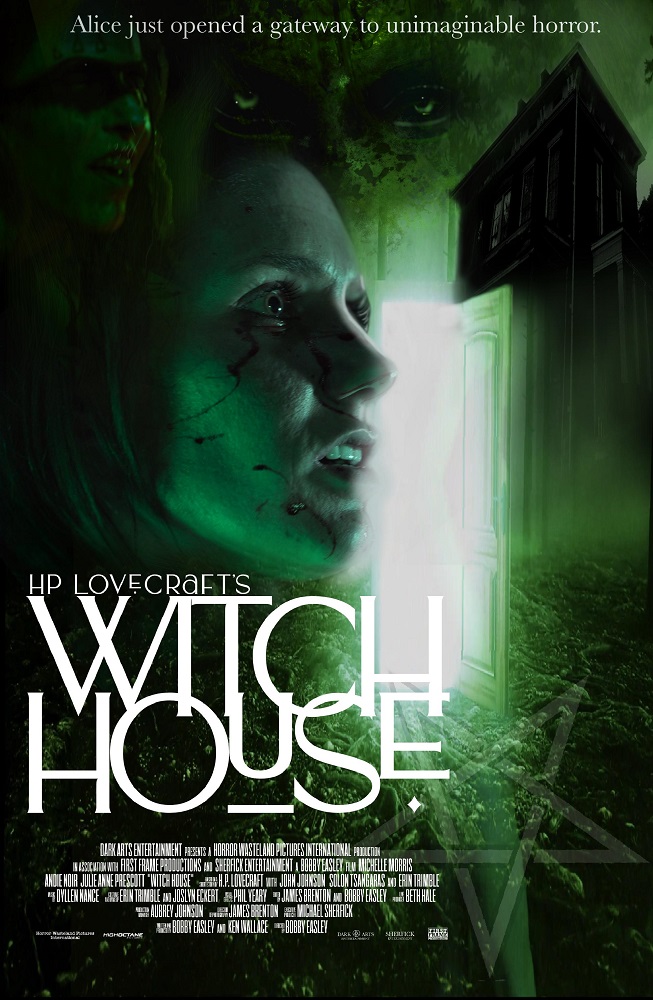USA. 2021.
Crew
Director – Bobby Easley, Screenplay – Bobby Easley & Ken Wallace, Based on the Short Story Dreams in the Witch House (1933) by H.P. Lovecraft, Producers – James Brenton, Bobby Easley & Ken Wallace, Photography – James Brenton, Music – Dyllen Nance, Special Effects – Zeus Lee & Phil Yeary, Makeup Supervisor – Erin Trimble. Production Company – Horror Wasteland Pictures International/Dark Arts Entertainment/First Frame Productions.
Cast
Michelle Morris (Alice Gilman), Julie Anne Prescott (Tommi), Erin Trimble (Kelly), Andie Noir (Kenzie Mason), John Johnson (Professor Sherfick), Bill Levin (Vespuli), Solon Tsangaras (Brown Jenkin)
Plot
Alice Gilman rents a room in the Hannah House, although the only room the owner will give her is the attic. Alice befriends the owner’s niece Tommi, who shows her some of the secrets of the house, while the two also become lovers. Alice has a fascination with occult geometry and lectures on the subject. However, she ignores warnings she is given about the house. She is soon plunged into a series of nightmare hallucinations and is dragged to an occult ceremony where she is intended to bear the Devil’s child.
H.P. Lovecraft (1890-1937) was an author writing in the 1920s and 30s who created a fascinating body of work that broods with a sense of cosmic horror, of scientists uncovering forbidden knowledge, elder gods slumbering and awaiting to be released, ancient prehistoric races emerging and the like. (For greater detail see Lovecraftian Films).
The Dreams in the Witch House (1933) is a Lovecraft story, originally published in Weird Tales magazine. The story concerns student Walter Gilman who moves into the attic of the Witch House in Arkham. The attic is constructed according to occult geometry and he soon begins having dreams in which he travels to other astral planes and is haunted by appearances of the witch Keziah Mason. The story previously formed the basis of two other films, both uncredited, with supposedly The Curse of the Crimson Altar (1968) and more directly The Dark Sleep (2013), while Stuart Gordon made a direct adaptation with Dreams in the Witch-House (2005), an episode of the horror anthology tv series Masters of Horror and Catherine Hardwicke subsequently conducted an adaptation with the The Dreams in the Witch House (2022) episode of Guillermo del Toro’s Cabinet of Curiosities. The Lovecraft story is never directly credited as the basis of the film here either – the film just calls itself H.P. Lovecraft’s Witch House and it would take a knowledge of Lovecraft’s bibliography to connect that up as being an adaptation of the story.
The film pays its obeisance to the Lovecraft story even if it is not a particularly good adaptation, including a reading from sections of the story over the opening credits. Dropped is the journey to the astral plane and other dimensions, no doubt for budgetary reasons. Lovecraft’s central character gets a gender-flip and for entirely contrived reasons moves into the attic (because it is the only room the owner will rent out). I was intrigued how the film was going to depict the idea of occult geometry on the low-budget it has – indeed, how it would be possible for any film to give visual representation to such an idea – but the film sidesteps this by merely having Michelle Morris obsessed with the topic and even giving a lecture on it (not that any of these make clear what occult geometry actually is).

The film has obtained the use of the real-life Hannah House in Indianapolis. The house was built in 1858 by a gold prospector who had struck it rich and at one point it ended up being used as part of the Underground Railroad. It is regarded as an historic landmark and has gained a reputation as a haunted house where it has been investigated by various ghost hunters and the like. Indeed, this haunted reputation is part of the house’s tourist sell today.
The main problem with the film is that it is all about the locale of a house that the filmmakers have attained use of for filming. We get various connections and nods to the H.P. Lovecraft story but not much else. There is not even really much of a story to the proceedings. We get scenes of Michelle Morris fascinated with occult geometry and the house. There is time aside for a lesbian love affair with Julie Anne Prescott, the daughter? niece? of the owner, but never any scenes where Michelle starts to uncover the house’s secrets.
Rather than any ventures to astral planes, the latter third of the film turns into a parade of dreams and hallucination scenes, filled with occult orgies with hooded figures chanting in circles and pursuing Michelle Morris through the house and woods, as well as her impregnation by The Devil. In these scenes, Bobby Easley does no more than draw on stock images of The Occult and Black Magic Film but delivers nothing out of the ordinary.
This was the fourth film for director Bobby Easley who has elsewhere made the horror films All Sinner’s Night (2014), Belly Timber (2016) and co-directed The Dead Bodies in #223 (2017), as well as the non-genre war film The Devil Dogs of Kilo Company (2015).
Other films based on the works of H.P. Lovecraft include:- The Haunted Palace (1963), Die, Monster, Die/Monster of Terror (1965), The Shuttered Room (1967) and The Dunwich Horror (1969). The big success in the modern era was Stuart Gordon’s splattery black comedy version of Re-Animator (1985), which popularised Lovecraft on film. This led to a host of B-budget Lovecraft adaptations, including Stuart Gordon’s subsequent From Beyond (1986), The Curse (1987), The Unnameable (1988), The Resurrected (1992), Necronomicon (1993), The Unnamable II: The Statement of Randolph Carter (1993), Lurking Fear (1994), Stuart Gordon’s Dagon (2001), The Dream-Quest of Unknown Kadath (2003), Beyond the Wall of Sleep (2006), H.P. Lovecraft’s Cool Air (2006), Chill (2007), Cthulhu (2007), The Tomb (2007), Colour from the Dark (2008), The Dunwich Horror (2009), The Color (2010), Pickman’s Muse (2010), The Whisperer in Darkness (2011), The Dark Sleep (2013), The Haunter of the Dark (2015), Herbert West: Re-Animator (2017), Color Out of Space (2019), H.P. Lovecraft’s The Deep Ones (2020), the tv series Lovecraft Country (2020), Markham (2020), The Resonator: Miskatonic U (2021), The Lurking Fear (2023), Suitable Flesh (2023), H.P. Lovecraft’s The Old Ones (2024), The Innsmouth School for Girls (2024) and Unspeakable: Beyond the Wall of Sleep (2024). Lovecraft: Fear of the Unknown (2008) is a documentary about Lovecraft. Also of interest is The Manitou (1978), which features an appearance of the Great Old One; Cast a Deadly Spell (1991) and its sequel Witch Hunt (1994), a tv movie set in an alternate world where magic works and where the central character is a detective named H.P. Lovecraft; Juan Piquer Simon’s cheap and loosely inspired Cthulhu Mansion (1992); John Carpenter’s Lovecraft homage In the Mouth of Madness (1995); the fan parody The Last Lovecraft: Relic of Cthulhu (2009) and the parody Call Girl of Cthulhu (2014); even a trilogy of animated children’s film Howard Lovecraft and the Frozen Kingdom (2016), Howard Lovecraft and the Undersea Kingdom (2017) and Howard Lovecraft and the Kingdom of Madness (2018) in which a young Lovecraft encounters his own creations; while Batman faces Lovecraftian horrors in the animated Batman: The Doom That Came to Gotham (2023); and Lovecraft homages such as The Breach (2022), H.P. Lovecraft’s Monster Portal (2022) and Gods of the Deep (2023). The Elder Gods turn up at the end of The Cabin in the Woods (2012), Lovecraft (Paul Titley) appears as an imaginary companion in Ghostland/Incident in a Ghostland (2018) and In Search of Lovecraft (2008) features a tv news crew discovering that Lovecraft’s works are true. Lovecraft’s key work of demonic lore The Necronomicon also makes appearances in films such as Equinox (1970), The Evil Dead II (1987) and Army of Darkness (1992), and was also borrowed as an alternate retitling for Jesus Franco’s surreal and otherwise unrelated Succubus/Necronomicon (1969) about a BDSM dancer.
Trailer here


